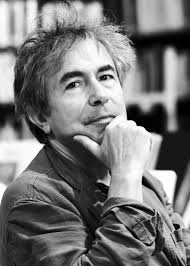Critic by François Jullien
 BETWEEN THERE IS AND THERE ISN’T
BETWEEN THERE IS AND THERE ISN’T
Here and there, shapes sporadically begin to appear, minimally, emerging out of the surrounding non defined-ness, standing firm and at times even sharp.
Is this a portico, some sort of Japanese tori serving as a threshold? But where does it lead to? To one of these three interconnected arms? Or is it the Greek pi π, expressing incommensurability, defying rationality?
The outline stands out naked, elemental, yet is not symbolic. It indicates that something is taking place, is emerging, has begun its individuation; it keeps our attention in suspense without contenting it.
Lonely, scattered, slender yet firm, these three poles tear us away from the opacity of things, but they do not constitute a sign: rather than inhabiting the landscape, they enhance its emptiness and make its forlornness tangible.
Between « there is » and « there isn’t», you wu zhi jian 有无 之閒
This protrusion underlines the diffuse blandness surrounding it: all is smooth, the eye glides by, diving into indifferentiation.
Either some form of granulation seeps through to the surface, here and there, and begins to catch the eye – a hint of movement, a stretch of foam. But no form encloses this asperity, neither lends it contours nor leads it toward figuration.
Or a line appears from without, detaching itself from an abstract stroke, withdrawing into itself almost elliptically, like a burst of light: its flattened out circle surrounds, enhances, leads our attention toward something, but we don’t know what.
Because the ink saturates, leaving things evasive. Thus, that which emerges and is hinted at is not symbolic; as I have said, it does not open space for interpretation, it is allusive : it calls out to another dimension, but does not cut all ties with the sensitive world. It leads to a disadherence, which does not convert the eye, does not direct it toward an intelligible world.
« Landscape beyond landscape », jing wai jing 景外景, in Chinese; or “taste beyond taste”, wei wai wei
味外味.
The power, or rather, the readiness of ink; ink opens up betweenness and lets things through, indefinitely.
By varying continuously, by waning and regaining life, by darkening or diluting, it lets things through, allows them to diffuse and impregnate.
Thus, instead of capturing an essence, thanks to its substance, instead of building meaning through figuration, as painting has so often striven to do, it dissolves figuration and allows it to emanate.
It makes us dream of elsewhere, but an elsewhere that arises from within, spreads from within. Infinity is no longer folded into a “Heaven”, yonder, behind its horizon, creating a separation – but unfolds out of the diluted.
ENTRE IL Y A - IL N'Y A PAS
Des formes s’esquissent, çà et là, sporadiquement, minimalement, émergeant de l’indéfinition d’alentour, se campant fermes et même parfois acérées.
Est-ce un portique, quelque tori japonais faisant seuil – mais vers quoi ? – de ces trois bras raccordés ? Ou bien est-ce là le pi π grec de l’incommensurable, défiant la rationalité ?
Ce tracé qui se détache est nu, élémentaire, mais n’est pas pour autant symbolique. Il signale que quelque chose a lieu, émerge, a commencé de s’individuer, maintient l’attention en suspens, mais sans pourtant la contenter.
Esseulés, épars, graciles, mais fermes à la fois, ces trois poteaux font décoller de l’opacité des choses, mais ils ne font pas signe : au lieu de meubler le paysage, ils le rendent déshabité, font éprouver son esseulement.
Entre « il y a » - « il n’y a pas », you wu zhi jian 有无 之閒
Ce saillant fait ressortir le diffus, la fadeur d’alentour, où tout est lisse, sur quoi le regard glisse, plongeant dans l’indifférencié.
Ou bien quelque granulation monte à la surface, ici et là, à quoi la vue commence d’accrocher – début de moutonnement ou trait d’écume. Mais aucune forme n’enferme cette aspérité, ne la borde et ne la destine à la figuration.
Ou bien alors la ligne intervient du dehors, se détachant d’un trait abstrait, se repliant sur lui-même, quasiment elliptique, tel un jet de lumière : elle entoure de son cercle aplati, fait ressortir, désigne à l’attention, mais on ne sait pas quoi.
Car l’encre, en imbibant, laisse évasif. Aussi ce qui émerge et qui s’esquisse est-il, non pas symbolique, donnant à interpréter, je l’ai dit, mais allusif : appelant vers un au-delà, mais qui ne rompt pas avec le sensible ; portant à une désadhérence, mais qui ne convertit pas le regard, ne le tourne pas vers un monde de l’intelligible.
« Paysage d’au-delà le paysage », jing wai jing 景外景, dit le chinois ; ou « saveur d’au-delà la saveur », wei wai wei 味外味.
Pouvoir, ou mieux, disponibilité de l’encre : l’encre ouvre de l’entre et laisse indéfiniment passer.
En variant continûment, en s’estompant et s’avivant, se fonçant ou se diluant, elle laisse passer à travers, se diffuser et imprégner.
Au lieu donc qu’elle cerne une essence par sa matière, qu’elle édifie du sens par sa figuration, comme l’a tant voulu la peinture, elle dissout la figuration et la laisse émaner.
Elle fait rêver d’un ailleurs, mais qui se dégage de l’intérieur, se répand du dedans. L’infini n’est plus replié dans un « Ciel », retranché derrière sa ligne d’horizon, formant séparation – mais se déploie du dilué.

